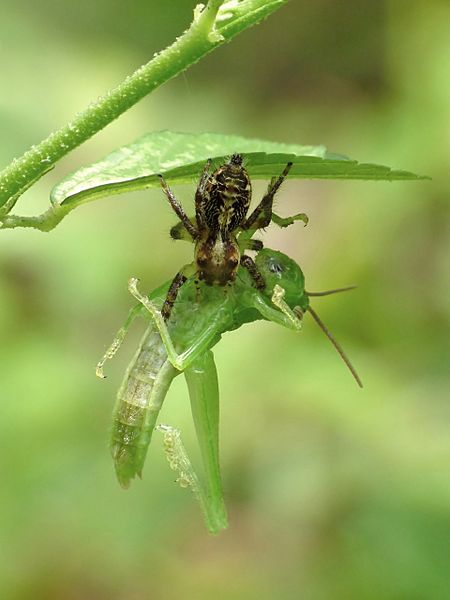Image: Jumping spider hunting a grasshopper by Kadavoor

Description: Jumping spiders are generally diurnal, active hunters. Their well-developed internal hydraulic system extends their limbs by altering the pressure of body fluid (hemolymph) within them. This enables the spiders to jump without having large muscular legs like a grasshopper. Most jumping spiders can jump several times the length of their bodies. When a jumping spider is moving from place to place, and especially just before it jumps, it tethers a filament of silk (or 'dragline') to whatever it is standing on to protect itself if the jump should fail. Should it fall, for example if the prey shakes it off, it climbs back up the silk tether. Some species, such as Portia, will actually let themselves down to attack prey such as a web spider apparently secure in the middle of its web. The hunting behaviour of the Salticidae is confusingly varied compared to that of most spiders in other families. Salticids hunt diurnally as a rule, which is consistent with their highly developed visual system. When it detects potential prey, a jumping spider typically begins orienting itself by swivelling its cephalothorax to bring the anterior median eyes to bear. It then moves its abdomen into line with its cephalothorax. After that, it might spend some time inspecting the object of its attention and determining whether a camouflaged or doubtful item of prey is promising, before it starts to stalk slowly forward. When close enough, the spider pauses to attach a dragline, then springs onto the prey. Having made contact with the prey, hunting Salticidae administer a bite to inject rapidly acting venom that gives the victim little time to react. In this respect, they resemble the Mimetidae and Thomisidae, families that ambush prey that often are larger than the predator, and they do so without securing the victim with silk; they accordingly must immobilise it immediately and their venom is adapted accordingly.
See how this small female jumping spider, Hyllus semicupreus, successfully captured a grasshopper that is much larger and stronger than she is. The grasshopper tried to escape, but the spider immobilized it using the venom she injected, and the "dragline" helped her hold her position with respect to the prey object.
Author: Jeevan Jose, Kerala, India
Usage Terms: Creative Commons Attribution-Share Alike 3.0
License: CC-BY-SA-3.0
License Link: http://creativecommons.org/licenses/by-sa/3.0/
Attribution Required?: Yes
Image usage
The following page links to this image:

